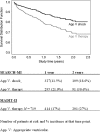Clinical and arrhythmic outcomes after implantation of a defibrillator for primary prevention of sudden death in patients with post-myocardial infarction cardiomyopathy: The Survey to Evaluate Arrhythmia Rate in High-risk MI patients (SEARCH-MI)
- PMID: 19136492
- PMCID: PMC2659601
- DOI: 10.1093/europace/eun349
Clinical and arrhythmic outcomes after implantation of a defibrillator for primary prevention of sudden death in patients with post-myocardial infarction cardiomyopathy: The Survey to Evaluate Arrhythmia Rate in High-risk MI patients (SEARCH-MI)
Abstract
Aims: To evaluate clinical and arrhythmic outcomes in post-infarction cardiomyopathy patients implanted with a defibrillator (ICD) for primary prevention of sudden death.
Methods and results: The SEARCH-MI registry is a European multi-centre, prospective, observational study enrolling patients after myocardial infarction, chronic left ventricular dysfunction and an ICD implanted for primary prevention of sudden death. Data on 556 patients with at least one recorded follow-up are presented. Survey to Evaluate Arrhythmia Rate in High-risk MI (SEARCH-MI) patients were sicker than those enrolled in MADIT-II with higher New York Heart Association class and left bundle branch block. Total mortality was 10.4%. Close to one-third (30%) of patients experienced episodes of sustained ventricular arrhythmia. One-quarter (23%) received at least one appropriate therapy and 10% inappropriate therapy. Gender (25% males vs. 5% females, P = 0.0009) and history of non-sustained ventricular tachycardia (24% with vs. 18% without P = 0.037) were predictive of appropriate ventricular therapy.
Conclusion: SEARCH-MI represents the current clinical management of post-MI patients with left ventricular dysfunction indicated to defibrillator implant for primary prevention. European routine clinical practice was influenced by landmark trials and guidelines which impacted on the implantation of cardiac resynchronization therapy in over 25% of such patients. Non-sustained ventricular tachycardia identifies subjects with a higher incidence of appropriate ICD therapy.
Figures



Comment in
-
Primary prevention: a necessity after myocardial infarction with left ventricular dysfunction.Europace. 2009 Apr;11(4):407-8. doi: 10.1093/europace/eup041. Epub 2009 Mar 11. Europace. 2009. PMID: 19279027 No abstract available.
References
-
- Zipes DP, Libby P, Bonow RO, Braunwald E. Braunwald's Heart Disease: A Textbook of Cardiovascular Medicine. 7th ed. Saunders and Co; 2004.
-
- Bigger JT, Jr, Fleiss JL, Kleiger R, Miller JP, Rolnitzky LM. The relationships among ventricular arrhythmias, left ventricular dysfunction, and mortality in the 2 years after myocardial infarction. Circulation. 1984;69:250–8. - PubMed
-
- Buxton AE, Marchlinski FE, Waxman HL, Flores BT, Cassidy DM, Josephson ME. Prognostic factors in non-sustained ventricular tachycardia. Am J Cardiol. 1984;53:1275–9. - PubMed
-
- Ruskin JN, McGovern B, Garan H, DiMarco JP, Kelly E. Antiarrhythmic drugs: a possible cause of out-of-hospital cardiac arrest. N Engl J Med. 1983;309:1302–6. - PubMed
-
- Echt DS, Liebson PR, Mitchell LB, Peters RW, Obias-Manno D, Barker AH, et al. Mortality and morbidity in patients receiving encainide, flecainide, or placebo. The Cardiac Arrhythmia Suppression Trial. N Engl J Med. 1991;324:781–8. - PubMed
Publication types
MeSH terms
LinkOut - more resources
Full Text Sources
Medical

